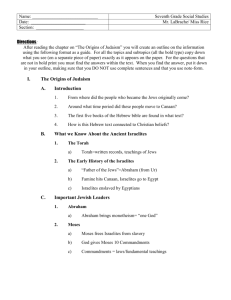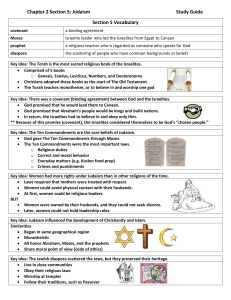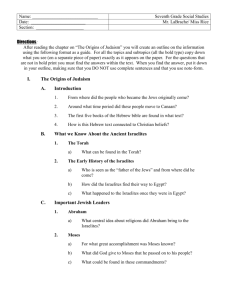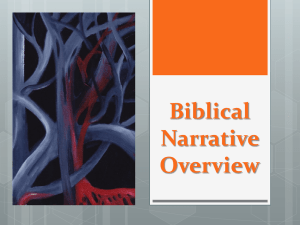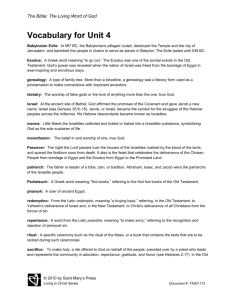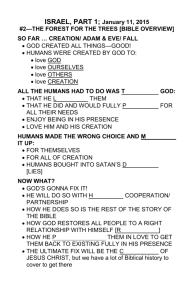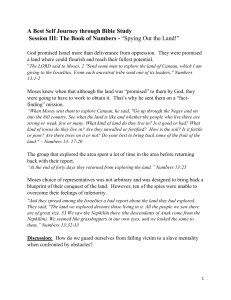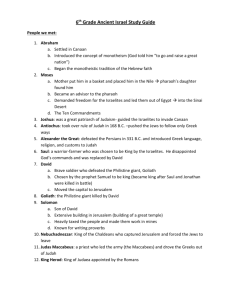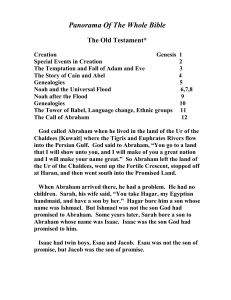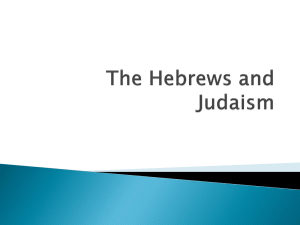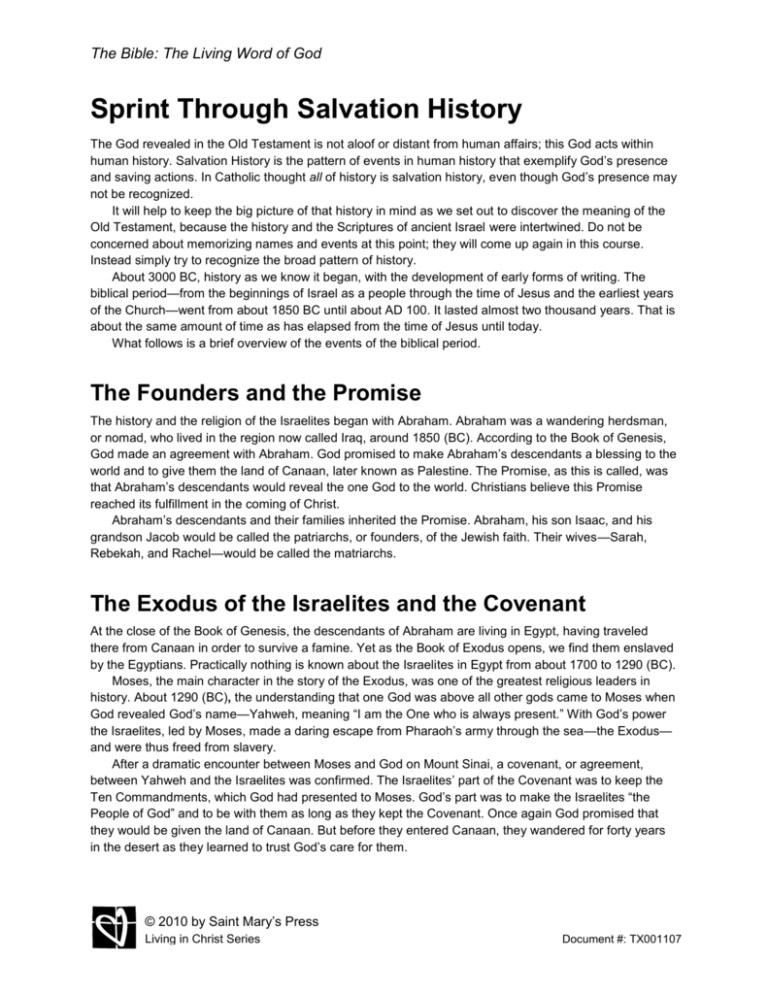
The Bible: The Living Word of God
Sprint Through Salvation History
The God revealed in the Old Testament is not aloof or distant from human affairs; this God acts within
human history. Salvation History is the pattern of events in human history that exemplify God’s presence
and saving actions. In Catholic thought all of history is salvation history, even though God’s presence may
not be recognized.
It will help to keep the big picture of that history in mind as we set out to discover the meaning of the
Old Testament, because the history and the Scriptures of ancient Israel were intertwined. Do not be
concerned about memorizing names and events at this point; they will come up again in this course.
Instead simply try to recognize the broad pattern of history.
About 3000 BC, history as we know it began, with the development of early forms of writing. The
biblical period—from the beginnings of Israel as a people through the time of Jesus and the earliest years
of the Church—went from about 1850 BC until about AD 100. It lasted almost two thousand years. That is
about the same amount of time as has elapsed from the time of Jesus until today.
What follows is a brief overview of the events of the biblical period.
The Founders and the Promise
The history and the religion of the Israelites began with Abraham. Abraham was a wandering herdsman,
or nomad, who lived in the region now called Iraq, around 1850 (BC). According to the Book of Genesis,
God made an agreement with Abraham. God promised to make Abraham’s descendants a blessing to the
world and to give them the land of Canaan, later known as Palestine. The Promise, as this is called, was
that Abraham’s descendants would reveal the one God to the world. Christians believe this Promise
reached its fulfillment in the coming of Christ.
Abraham’s descendants and their families inherited the Promise. Abraham, his son Isaac, and his
grandson Jacob would be called the patriarchs, or founders, of the Jewish faith. Their wives—Sarah,
Rebekah, and Rachel—would be called the matriarchs.
The Exodus of the Israelites and the Covenant
At the close of the Book of Genesis, the descendants of Abraham are living in Egypt, having traveled
there from Canaan in order to survive a famine. Yet as the Book of Exodus opens, we find them enslaved
by the Egyptians. Practically nothing is known about the Israelites in Egypt from about 1700 to 1290 (BC).
Moses, the main character in the story of the Exodus, was one of the greatest religious leaders in
history. About 1290 (BC), the understanding that one God was above all other gods came to Moses when
God revealed God’s name—Yahweh, meaning “I am the One who is always present.” With God’s power
the Israelites, led by Moses, made a daring escape from Pharaoh’s army through the sea—the Exodus—
and were thus freed from slavery.
After a dramatic encounter between Moses and God on Mount Sinai, a covenant, or agreement,
between Yahweh and the Israelites was confirmed. The Israelites’ part of the Covenant was to keep the
Ten Commandments, which God had presented to Moses. God’s part was to make the Israelites “the
People of God” and to be with them as long as they kept the Covenant. Once again God promised that
they would be given the land of Canaan. But before they entered Canaan, they wandered for forty years
in the desert as they learned to trust God’s care for them.
© 2010 by Saint Mary’s Press
Living in Christ Series
Document #: TX001107
Sprint Through Salvation History
Page | 2
Taking Over the Promised Land
After Moses’ time the Israelites, led by Joshua, entered Canaan. Over the next centuries—from about
1250 to 1000 (BC)—they fought against the people who lived in that region. In these battles the Israelites
were led by military leaders called judges. During this time the Israelites abandoned their nomadic ways
for the more settled agricultural life that was native to the region.
The Nation and the Temple
Around 1000 (BC) Israel became recognized as a nation, with David as its anointed king and Jerusalem
as its capital city. God made a promise to David that his royal line would endure forever. (Later Jews put
their hopes in a descendant of David to save them from oppression.)
David’s son Solomon built the Temple in Jerusalem, and it became the principal place of worship for
the nation. As both a political and a religious capital, Jerusalem became a great and holy city.
The Kings and the Prophets
After Solomon’s death in 922 (BC), the nation divided, with the kingdom of Israel in the north and the
kingdom of Judah in the south. Heavy taxes and forced service in both kingdoms created hardships for
the people. In addition, the kings often practiced idolatry—the worship of idols (images of other gods).
Prophets spoke out against both kingdoms’ injustices to the people and infidelity to God. They
questioned the behavior of the kings and called them and their people back to the Covenant. Yet the
kingdoms continued to oppress the poor and worship pagan gods until eventually both kingdoms were
crushed by powerful conquerors. The Assyrians obliterated the northern kingdom of Israel in 721 (BC)
and took its people into exile. In 587 (BC) the Babylonians destroyed Judah, including the city of
Jerusalem, and took its people to Babylon as captives.
The Babylonian Exile and the Jewish Dispersion
While the people were exiled in Babylon, still other prophets encouraged them to repent of their sins and
turn back to God. During this time the prophet known as Second Isaiah proclaimed that God was the one
and only God. Monotheism, the belief in one God, was now the revelation of this people to the world, their
blessing to the nations.
After fifty years in Babylon, the exiles were released from captivity by the conquering Persians and
allowed to return home. Judah, no longer a politically independent kingdom, had become a district within
the Persian Empire, and the returned exiles became known as Jews, from the word Judah. They rebuilt
the Temple, and under Ezra and Nehemiah, they re-established the Law and restored Jerusalem. That
city became the religious capital for the Jews who had resettled all over the world—that is, the Jews of
the Dispersion.
During the Exile the Jewish leaders had begun collecting and reflecting on their ancestral writings,
forming the core of what would later become their Bible, known to Christians as the Old Testament.
© 2010 by Saint Mary’s Press
Living in Christ Series
Document #: TX001107
Sprint Through Salvation History
Page | 3
More Oppressors
The Persian Empire was conquered in 330 (BC) by the armies of Alexander the Great, leader of the
Greek Empire. This made the Greeks overlords of the Jews for nearly three hundred years, with the
exception of a brief period of independence after a revolt led by the Maccabees family. The Greeks were
followed by the Romans, who captured Jerusalem in 63 (BC). Although tolerant of other cultures and
religions, the Roman Empire severely punished its subjects for revolts.
It was a dark time for the people of the Promise, who longed for release from oppression and for the
day when all their hopes for a good and peaceful life would be fulfilled. Many Jews looked toward the
coming of a messiah, one sent by God to save them; some expected this messiah to be from the family
line of David.
It is at this point in the history of Israel that the Old Testament accounts end. . . .
Jesus, the Savior
Into a situation of defeat and darkness for the people of Israel, Jesus was born, one of the house, or
family line, of David. Christians see Jesus as the long-awaited Messiah—the fulfillment of all God’s
promises to Israel and the Savior of the world. With his Death and Resurrection, Jesus’ followers
recognized that he was the Son of God. The community of believers began to grow, first among Jews but
later among Gentiles, or non-Jews. The story of Jesus and the growth of the early Church is told in the
New Testament.
(This handout is adapted from Written on Our Hearts: The Old Testament Story of God’s Love, Third Edition, by Mary Reed
Newland [Winona, MN: Saint Mary’s Press, 2009], pages 18–24. Copyright © 2005 by Saint Mary’s Press. All rights reserved.)
© 2010 by Saint Mary’s Press
Living in Christ Series
Document #: TX001107

